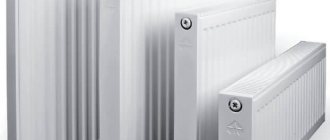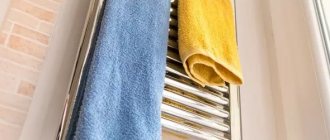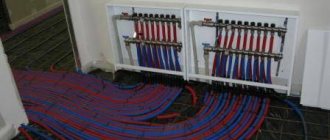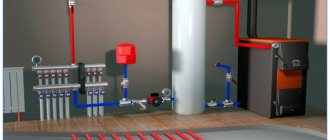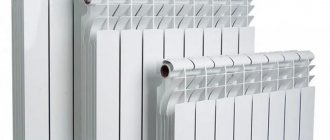After the heating season ends, many begin to think about replacing old radiators. A significant percentage of housing in Russia is represented by panel buildings from Soviet times.
Aluminum radiator - appearance
The cast iron batteries installed inside them, although they can last for decades, sooner or later become unusable. They develop microcracks, rust and become unsafe. As soon as you discover the first holes, rest assured that it’s time to send the cast-iron monsters to a well-deserved rest. To replace them, the market offers two main types of batteries. In order not to get lost in the choice, it is important to understand what is the main difference between aluminum heating radiators and bimetallic ones.
To choose the right radiator model, it is best to contact professional repairmen. However, if this is not possible, you will have to figure it out yourself and consult with sellers in specialized stores.
Some sellers will try to confuse you, because their goal is to sell the product at a higher price. In addition, other careless sellers may try to sell you aluminum radiators under the guise of bimetallic ones, and you should know how to distinguish them so as not to overpay for non-existent additional functions! To avoid falling for their tricks, read this article carefully.
Features of bimetallic radiators
The second option that the store can offer you is a bimetallic radiator.
The prefix “bi” in the word “bimetallic” means “two”. This name is given to this type of battery because they are made from two metals: steel and aluminum. Let's immediately turn to the positive characteristics of this species:
- The steel in the material from which the body is made will perfectly withstand any surges in water pressure. It is also not subject to corrosion. These properties of the metal ensure high strength and many years of faithful service of the device;
- steel sheet provides serious protection of the case from external mechanical damage;
- active coolant circulation;
- Aluminum coating will ensure rapid heating of the air in the living room;
- battery operating pressure can reach 40 atm;
- the maximum possible coolant temperature is approximately 130 degrees, while for aluminum products it is only 110;
- durable paint coating on the body. This stability is achieved through a two-stage dyeing mechanism:
- First of all, the product is placed in a dye solution and completely covered with paint;
- Then another polymer layer based on epoxy resin is sprayed on top of the dried first paint. Radiators processed using this technology not only look very aesthetically pleasing, but also take on clearer geometric shapes;
easy installation and transportation, especially if you seek the help of professionals. The design of bimetallic batteries is no more complicated than that of simple aluminum ones, however, their installation is also best left to professionals. How long the batteries are installed correctly, the longer they will serve you; the ability to add additional sections directly to your home
However, if you assume that you still want to increase their number, when purchasing, pay attention to the design of the radiator housing. Some of the models on the market have a solid steel core, so they are not divided into sections.
Bimetallic radiator section
One of the options for the appearance of a bimetallic radiator
Let's pay attention to the disadvantages of bimetal devices:
- aluminum used in combination with steel loses its high heat-transfer properties. Due to the steel core inside the battery, you will have to wait a little longer than you are used to for the air to reach the desired temperature;
- increased price. Since the price of steel is higher than silicon, the cost of bimetallic batteries also increases by about 30% compared to aluminum ones;
- increased operating costs. Since bimetallic devices boast increased hydraulic resistance, the amount of energy spent on water circulation will also increase;
- Improper use of radiators can lead to corrosion of its steel parts. This will definitely happen if bimetallic batteries are installed in your dacha, which is not used in winter. As soon as the autumn heating season comes to an end, it will be necessary to carry out the procedure of draining the water from the system. It is because of this that corrosion processes will begin: simultaneous contact of steel with air and water instantly starts them.
- The small tube passage inside the device is subject to rapid clogging. This shortens the service life of the device.
Important! The coefficients of thermal expansion of steel and aluminum differ, which is why the battery begins to emit loud crackling sounds after a short period of time. This sound does not mean that there is a problem inside the device.
Don't worry, your health is safe!
These modern radiators can function properly even in rooms where the air humidity level is high. Their surface is resistant to corrosion. The radiator is given such resistance to aggressive environmental influences by sheet steel, which covers the body of the device with a protective layer.
Inside bimetallic radiators there are water channels of small cross-section. Due to their modest size, they are filled as quickly as possible with hot water coming from a centralized water supply system or an autonomous boiler.
Construction professionals consider purchasing bimetallic batteries and installing them during renovations as one of the best functional improvements to an apartment. Over time, the use of these devices will fully pay for the money spent on them.
Differences
Anodized aluminum appliances are made from high-quality material and are subjected to anodic oxidation to increase corrosion resistance. Aluminum radiators can withstand operating pressures of up to 16 atmospheres, anodized models - up to 69–70 atmospheres. Bimetallic structures, as mentioned above, are made of two materials. The body with fins made of aluminum alloy has a core of pipes inside where the coolant flows. The pipes are made of steel, due to which such radiators can withstand very high pressure, reaching up to 60 atmospheres, which allows them to be used in high-rise buildings.
Aluminum radiators have the following positive characteristics:
- the ability to choose different models by color, type, size;
- ease of installation and transportation;
- compactness - the width usually does not exceed 10 cm, which is why the device will not take up much space in the room;
- high operating pressure - this indicator is very important for the operation of the heating device;
- you can install several sections, which will increase the power and, therefore, provide heat to large rooms;
- some models are equipped with a thermostat with which you can adjust the heating temperature;
- relatively low price;
- heat transfer allows you to maintain a comfortable temperature level in the room.
Bimetallic devices have the following advantages:
- reliability – this type of radiator can last 20–30 years without interruption;
- corrosion resistance - the materials from which bimetallic batteries are made practically do not react to an alkaline environment;
- quick response to thermostat commands - using a core installed in the radiator, the device heats up in a matter of seconds and also cools instantly;
- ease of installation;
- safety, durability and strength;
- high heat transfer;
- small size and weight;
- wide range of uses.
The installation process of aluminum and bimetallic heating devices has approximately the same installation principle, however, a detailed and accurate comparison indicates that the assembly of a heating system with aluminum radiators is simpler and more accessible for independent work. And also both heating options have almost the same appearance. If we compare the range of use, it is worth noting that bimetal devices, due to their high operational resistance to atmospheric pressure, can be installed in all types of premises, unlike some models of aluminum structures. If we compare the difference in heat transfer, then aluminum devices are in the lead. One section of this type of radiator can provide 200 W of thermal energy. The heat transfer in bimetallic batteries depends on the specific model, but almost always the figure will be lower than that of aluminum analogues.
Aluminum can withstand boiling water up to +110 degrees, while bimetallic ones can withstand up to +130 degrees. The price of bimetal radiators is significantly higher than their aluminum competitors, almost 1/3. For this reason, many buyers prefer the latter. Among the disadvantages of aluminum radiators, it is worth noting their poor resistance to corrosion. The activity of aluminum does not allow the device to be used under standard heat supply conditions for a long time. As a result of some chemical processes in the heating system using aluminum structures, airing may occur. Among the disadvantages of bimetallic devices, they note their higher price compared to aluminum radiators, as well as more complex repairs in case of breakdown.
Which radiators to choose - recommendations
In various forums dedicated to heating private houses and apartments, debates on this topic do not subside. The average homeowner or renter who goes there looking for information may never find the truth. The situation is aggravated by artificially created myths that have one goal: to sell some product.
We have debunked the main myth regarding the insufficient working pressure of aluminum radiators, but there are others:
- when working in centralized networks, silumin is quickly corroded by corrosion, so only bimetal is needed;
- aluminum forms a galvanic couple with some other metal in contact with the coolant, and therefore is quickly destroyed;
- as a result of chemical reactions of the aluminum alloy with dirty water, a lot of oxygen is released into the system;
- the steel inserts of bimetallic batteries rust and rot through, which is why the section has to be thrown away;
- other incredible stories.
The processes described in myths take place, but to a very small extent. It takes decades, not years, for any serious consequences to occur. Provided that you did not buy a cheap fake and installed the batteries correctly. And there are steel parts in aluminum heating devices (connecting nipples).
Finally, we will give a number of recommendations to help you choose the best radiators for your home:
- The optimal solution for autonomous heating systems powered by their own boiler is aluminum batteries.
- They are also perfect for working in apartment buildings. Just buy quality products from trusted manufacturers and do not forget to compare the operating pressure.
- In multi-apartment high-rise buildings (16 floors or more), it is better to install bimetallic radiators.
- If the heating system of a high-rise building is not a riser system, but with horizontal branches entering each apartment, then aluminum radiators can be installed.
- Advice to users who are not convinced by any arguments: buy and install bimetallic heating devices in your home and feel calm.
Any radiators connected to central heating will last longer and heat more efficiently if they are periodically flushed. Ideally - annually, at least - once every 3 years. You can also learn a lot of valuable tips on choosing suitable batteries from our expert’s video:
Who is warmer?
The efficiency of aluminum radiators is higher than that of steel, but only on average. If you compare a regular aluminum battery and a class 33 steel radiator, the latter will be able to give off more heat. But it is worth considering the type of radiator connection and the water flow rate.
Example
If you have a class 33 steel radiator installed and the water flow rate is low, it will work efficiently. That is, it will take maximum heat from the water. If a single-pipe connection is used, this is bad - cooled water will enter the next heating device and it will not heat.
If a steel radiator of class 11 or 22 is installed, then they will also heat well, but will not have time to cool the water.
It is impossible to say exactly how much more heat transfer from an aluminum radiator is greater than that of a steel radiator - a lot depends on the design and thickness of the metal. On the one hand, the thermal conductivity of steel is on average 3.5-4.5 times worse than that of aluminum. But the thickness of the steel radiator tubes is also less, which can compensate for this difference.
Differences between bimetallic radiators and aluminum ones
Choosing a heating device is a serious matter; not only the temperature in the room during winter depends on it, but also the reliability and long-term use of batteries under different conditions. You need to know the technicians. the capabilities of heating products made from various materials and their main differences affecting the validity of the choice in any particular case.
At the moment, according to the responses of professionals and users, two types of batteries are considered more effective - bimetallic and aluminum.
Before making comparisons, you need to better understand the performance capabilities of aluminum and bimetallic batteries
Those. individuality of aluminum batteries
The body of such products is made of aluminum or its alloys. To produce products, they use the casting method or a press at high temperatures. Cast sections are the highest quality and most reliable. Aluminum batteries are equipped with ribs between sections and vertical panels in front, this allows for the highest thermal output, while thermal energy comes from both radiation and convection.
Aluminum radiators are not large and have many shapes. Traditionally, the segments are packaged in 2-3 sections and assembled into a heating battery of suitable volumes. Silicone or paronite gaskets are installed at the joints to isolate the joints. To connect the individual parts, bronze or brass nipples are used.
Those. The characteristics of aluminum radiators are good and not quite. The advantages of such products are:
- Highest thermal output (up to 250 W per section).
- Low thermal inertia.
- The batteries are compact and not heavy.
The disadvantages of aluminum batteries include:
- Inability to withstand high pressure in the heating network (no more than 10 Atm);
- Chemical instability of the material.
- Short shelf life (10 years).
- Demanding on the quality of the coolant.
Analyzing the properties listed above, it is clear that these radiators should not be used for central heating, since aluminum devices are in no way adapted to work at high pressure and poor quality coolant.
Bimetallic heating radiators, properties
The name of these products suggests that their main feature, compared to other batteries, is the use of two different metals in the production of the frame. Radiators of this type are iron pipes through which heated liquid circulates, they are pressed with external components made of aluminum or its alloy. Due to this unique individuality, bimetallic products retain excellent heat transfer characteristics due to aluminum and increased strength to iron parts .
The use of a steel core will reduce to a minimum the number of defects in a heating battery made from only aluminum.
Here are the main characteristics of batteries made using two metals:
- Excellent heat dissipation (200 W from one section).
- Fast heating speed.
- The devices are small-sized and not heavy.
- They do not hold a large volume of coolant.
- Withstand high pressure (20 atm working)
- The metal core is inert; modification of the reaction of the coolant medium affects it.
- Reliable (20 years of operation or more).
Poor qualities of bimetallic devices. The narrow clearance of the iron core can lead to rapid contamination and the high price of the products (on average thirty percent more expensive than similar aluminum ones). Bimetallic radiators are similar in appearance to aluminum radiators; their outer part is made of the same material.
It can be seen from the characteristics of aluminum batteries and those made from two alloys that their constant use under the same conditions is not possible. In particular, aluminum products are not suitable for central heating applications due to their inability to withstand dangerous pressure surges and sensitivity to water quality.
This means that of these two radiators, only bimetallic devices are suitable for central heating. Aluminum products are suitable for low-power heating systems and are good in the conditions of independent heating systems, in which the temperature of the circulating water is comparatively low.
When choosing a suitable device in the presence of an autonomous boiler, it is necessary to take into account the differences between aluminum radiators and bimetallic ones, taking into account not just one characteristic, but their complex. Devices made from two metals are more expensive and have lower heat transfer, but they are 2 times more durable.
How to distinguish an aluminum radiator from a bimetallic one
In life we have to deal with things that are difficult to understand at first glance. One such case is the problem of visual differences between bimetallic and aluminum radiators. After all, it would seem outwardly identical, but their characteristics and prices are different. Therefore, in order not to be deceived by the seller in the store or the craftsmen who install heating in your home, you need to distinguish between these types of radiators.
General structure of a bimetallic and aluminum radiator
To understand them, you first need to understand how each of these types of radiators works.
Aluminum radiator
Consists of homogeneous aluminum metal. Not pure, but alloyed with silicon for strength. It is cast in a special mold in sections or, less often, in blocks. The sections are screwed together using a threaded connection using a gasket to seal the joint.
The design of the section itself is designed in such a way that when assembled, several sections form petals with convection passages for better heat transfer.
Bimetallic radiator
As already mentioned, it is similar in appearance to aluminum, but there is a difference in the device. The internal part of the radiator section consists of horizontal and vertical steel pipes. Horizontal pipes are larger in diameter than vertical pipes. The outside of the pipes is “clad” in aluminum. The design of the aluminum “fur coat” is also ribbed, like that of all-aluminum ones.
Hence the external similarity. The sections are also screwed together using a threaded connection using a gasket. The individual tubes of the sections form a system of tubes in the form of a collector, which is designed to circulate coolant through it.
Since steel is much stronger than aluminum, bimetallic radiators can withstand much greater pressure and water hammer.
How to distinguish when purchasing
Now, knowing the design of both radiators, they won’t sell you aluminum radiators under the guise of bimetallic ones.
Pay attention to the place of the radiator where there is a thread for connecting the sections. In a bimetallic radiator, threads are cut into a steel pipe
Therefore, steel differs from aluminum in color; you can often observe the boundary of the two metals, again in the area of the thread (but sometimes this transition is not visible). Compare the weight of a bimetallic radiator with the weight of an aluminum radiator with the same size and equal number of sections. Steel is heavier than aluminum, so the weight of one section
bimetal can weigh up to half a kilogram more than its “double”. But in general, this difference will be sensitive even without the use of scales.
How to distinguish an already installed radiator
Imagine a situation where you hired a team to install a heating system, they installed it completely, they purchased all the materials themselves. You missed the moment when the radiators were not yet installed. Doubts have crept into your mind whether they installed aluminum batteries instead of bimetallic ones. This fact needs to be verified to dispel all doubts.
To do this, take a magnet, preferably neodymium. He is much stronger than others. But it can also be ordinary.
Bring the magnet somewhere on the edge of the radiator closer to its center, instead of as close as possible to the intended passage of the metal pipe. Steel is attracted to a magnet; aluminum does not have this property. Therefore, a bimetallic radiator will experience a slight attraction, since the magnet will not be located close to the pipe, but at some distance due to the aluminum shell surrounding it.
By the way, you can use a magnet on an uninstalled radiator by bringing it to the thread for connection. The effect of attraction will be clearly felt here if it is a bimetal.
Now knowing the differences in the design features and properties of these types of radiators, it will be impossible to deceive you and you will feel their warmth in your home for many years to come.
Maximum coolant temperature and its fluctuations
And the temperature of the coolant in our heating systems is not stable. Sometimes the pipes are barely warm, sometimes they are hot, like fire. It is important for us how the radiators will behave in the latter case, whether they can withstand too hot water. The indicators for this parameter are as follows. For a cast iron radiator, the coolant can heat up to 110 degrees. Hot water flowing through the pipes of a bimetallic radiator core can have a temperature of up to 130 degrees. But in general, both types of radiators tolerate temperature changes well. The only thing is that due to the difference in expansion of steel and aluminum, with a sharp change in temperature, you can hear small crackling sounds from the bimetallic radiator.
Maximum coolant temperature: Cast iron + | Bimetal +
Comparison of bimetallic heating radiators with steel and aluminum analogues
Heating batteries save people from the cold in winter.
This happened with the old cast iron “accordions”, the same thing happens with the stylish designs of the new generation.
When it comes to replacing heavy finned cast iron products, consumers often wonder what the difference is between bimetallic radiators and aluminum or steel structures.
The answer to this question lies in the method of their manufacture and technical characteristics.
The structure of aluminum batteries and their advantages
To win the attention and love of consumers, manufacturers modernize and improve heating radiators every year. Miracle alloys, convectors, new colors and painting methods, a combination of metals and elegant shapes are used.
With such a variety of choices, customers willy-nilly wonder how bimetallic heating radiators differ from aluminum, steel or cast iron counterparts. To understand, you should familiarize yourself with their manufacturing technology, weaknesses and strengths.
Manufacturers paid attention to aluminum due to its following properties:
- It is lightweight, which makes products made from it more attractive next to the heavy cast-iron batteries of the Soviet era.
- This metal is strong enough to cope with heating network pressure of up to 12-15 atmospheres.
- It is easy to give it any shape, which designers take advantage of when producing heating devices of various configurations.
- Special aluminum alloys give it additional strength, thereby extending the life of the finished product.
- Anti-corrosion internal coatings protect them from the aggressive environment of the heating network.
The first thing that distinguishes aluminum radiators from bimetallic ones is their technical parameters. Among the advantages, the following points can be noted:
- The fact that sections of aluminum radiators are produced by injection molding makes them resistant to any kind of mechanical loads, while maintaining the accuracy of their shapes.
- The silumin alloy, consisting of a combination of aluminum and silicon, allows the batteries to withstand low-quality coolant in the heating system.
- Aluminum has the highest heat transfer after copper - 190 W, while the same steel has only 47 W. This significantly saves energy resources, since both the radiator and the room warm up faster.
- Many models of aluminum radiators are equipped with thermostats, which makes them an even more economical option for heating an apartment or private house.
- Finished products weigh little, which makes them easy to transport and allows installation without inviting specialists.
- Their cost is low, which gives them an additional advantage in the eyes of consumers.
- They look stylish and fit into any interior.
Disadvantages of aluminum radiators
If you look for what the difference is between bimetallic and aluminum radiators, then most of all it is noticeable in the advantages of the former, which the latter lack.
Application for various heating purposes
After considering the main characteristics, pros and cons of the devices, you can decide on the option for the heating system.
Apartment heating main
Bimetallic models were created for use in urban environments. The water poured into the pipes has an aggressive chemical composition that does not affect the quality of the steel core. The element also provides resistance to hydrodynamic shock and pressure fluctuations. The small cross-section of the water channels allows the batteries to be quickly filled with water from a centralized boiler room.
A private house
The best option is aluminum devices that require high-quality coolant. The batteries are easy to operate under conditions of minimum pressure from 2 to 3 atm, and to regulate the temperature they can be equipped with a thermostat.
Country cottage
For heating in winter it is better to use aluminum modifications. They will provide maximum heat transfer, unlike bimetallic ones, which are expensive and will break quickly.
About the ability to withstand high pressure (especially water hammer)
The worst thing here is the aluminum product.
The working pressure of this material is up to 16 atmospheres. And this is not enough to withstand surges in the heating system. Water hammer is a large one-time surge in pressure. Aluminum radiators cannot be saved from it; they will shatter into fragments, like shells. It’s good if this happens not during the heating season. Otherwise, you cannot avoid a flood of hot water. This is why it is better not to use aluminum radiators in multi-storey buildings. Bimetallic batteries, due to the durable steel core inside, can withstand high pressure up to 40 atmospheres. If you open or close the pump tap at lightning speed, no accident will occur. In terms of reliability, in conditions of instability of system pressure, when water hammer is inevitable, only bimetal should be used
But this is important to consider for apartments with a central heating system, since there is no great pressure in the pipes of a private house and, accordingly, there is no threat of further flooding
Selecting a specific radiator model
Once you have decided on the type and type of heating radiators you need, it’s time to calculate and select specific models of these radiators that will have the necessary technical parameters.
Calculating thermal power
How to choose the right heating radiators to achieve the proper level of warmth and comfort? To do this, you need to calculate the thermal power of the radiators you plan to purchase. For certain standard conditions, a thermal power of 0.09 to 0.125 kilowatts per square meter of room is required. This is exactly the power that should be enough to create optimal climatic conditions in the room.
Now about what is meant by standard conditions. Everything is simple, this is a room in which there is a window with a wooden frame and three-meter (no higher) ceilings, as well as an entrance door. At the same time, hot water at a temperature of seventy degrees flows through the heating pipes. If you have the same conditions, then multiplying 0.125 by the area of the room you will get the power of the radiator or radiators (if several are required) required for the room. Next, all that remains is to look at the passport of specific radiators and, having found out there the thermal power of one section or the entire radiator, select the required model.
But this is a simple calculation; in fact, it is necessary to take into account some other factors that will have an impact in this case:
- You can reduce the power of radiators by 10 - 20% if you have plastic energy-saving double-glazed windows installed in your room, because they reduce heat loss in the room by approximately that amount.
- If there are not one, but two windows in the room, then you need to place a radiator under each of them. Their combined capacity should be 70% higher than the standard value. We will do the same in the case of a corner room.
- When the hot water temperature increases or decreases for every 10 degrees, we also increase (or decrease) the power of the device by 15-18%. The thing is that if the temperature of the coolant decreases, then the power of the heating radiators decreases.
- If the ceilings are higher than three meters, the heating power must again be increased. The increase must be made as many times as the 3-meter ceilings in the room are higher. If the ceilings are lower, then you need to make a reduction.
When making calculations, we will take into account how our radiators will be connected. Here are some recommendations on this matter:
- If the coolant enters the radiator from the bottom and comes out from the top, then a fair amount of heat will be lost - from 7 to 10%.
- The lateral one-sided supply makes it unreasonable to install radiators longer than 10 sections. Otherwise, the last sections of the pipe will remain practically cold.
- Gluing a special reflective insulating material to the wall behind the radiator increases heat transfer by 10 to 15 percent. For example, it could be a material such as Penofol.
Determine the required dimensions
When buying a radiator, you need to know exactly the following points:
- What type of eyeliner do you have - hidden or open?
- How are the pipes connected to the radiator, from the floor, from the wall, from above, from the side, etc.;
- Diameter of heating pipes;
- Distance between pipes (center distance).
We also provide for placing the radiator in such a way that air can flow freely around it - otherwise the room will not receive 10 to 15% of heat. The standards for placing radiators are as follows:
- The radiator distance from the floor is from 7 to 10 cm;
- distance from the wall – from 3 to 5 cm;
- distance from the window sill – from 10 to 15 cm.
Basic standards for the placement of radiators.
The final stage of purchasing radiators
Now, if you have autonomous heating, you can, taking these calculations with you, feel free to go to the store to buy heating appliances. But for residents of a high-rise building with a centralized heating system, it makes sense to first go to the emergency room after finding out what the operating pressure is in your heating system. We will build on this parameter when deciding which heating radiator is better to choose. The pressure indicated in the device passport must be higher than that indicated by the DEZ employees in order to obtain a certain reserve. After all, do not forget that in each new season, heating devices are tested with pressure testing, which is 1.5 times greater than the working one.
What is the advantage of a bimetallic battery?
The first thing I would like to draw your attention to is the small internal volume of the product, which allows you to save on heating a small amount of coolant without sacrificing room heating. Plus, bimetallic radiators have the following advantages:
- the ability to use coolant with any level of acid-base balance;
- the bimetallic battery can withstand very high pressure;
- to connect sections, only reliable paronite seals are used;
- bimetallic radiator has a high safety margin;
- thanks to the use of special dyeing technology, the finished product does not lose its visual appeal throughout its entire service life;
- long service life, which can exceed 25 years thanks to the use of steel pipes;
- high level of heat transfer achieved through the use of aluminum fins in the design of the heating battery.
Ease of installation due to the low weight of the bimetallic battery, the ability to build up additional sections directly at the installation site, attractive appearance and other characteristics make such radiators popular along with aluminum products.
How to distinguish a bimetallic radiator from an aluminum one?
As it may seem at first glance, an aluminum battery is practically no different from its bimetallic counterpart. But in reality, this statement is incorrect and can lead to the wrong choice of a suitable radiator. And if you plan to save on the cost of the heating device and buy the cheapest model, then it is possible that it will not work for long. Therefore, you need to understand the difference between a bimetallic radiator and an aluminum battery.
First of all, I would like to focus on the external similarity of the bimetallic and aluminum products. In shape they resemble a flat rectangular battery, painted white. If we consider the number of sections, then both battery models can be equipped with the required number of elements depending on the area of the heated room. The main difference between a bimetallic and aluminum radiator is located inside the device. Aluminum is a metal that is quite light and soft, so batteries made from it can be destroyed under constant stress. Simply put, the coolant pressure inside the system should not exceed 12 atmospheres. In turn, bimetallic radiators are able to withstand almost 3 times greater pressure. Also, these batteries differ in weight. The mass of steel is slightly greater than aluminum and therefore 1 section of a bimetallic radiator is approximately 500 Gy heavier than its aluminum counterpart. This difference is especially noticeable in products with a large number of sections. Well, the main difference between a bimetallic and aluminum battery is the service life of the devices. Aluminum radiators are significantly inferior to bimetallic batteries in this regard. The service life of aluminum products reaches 15 years
In turn, the combined unit has an operational life of more than 25 years, which is important for any heating system.
Based on the above, we can come to the conclusion that in private housing construction an aluminum battery is considered the best in terms of price and quality, and for apartment buildings a bimetallic radiator is suitable. Plus, modern products are equipped with everything necessary for self-installation, from wall brackets to an air vent. Therefore, installation of both aluminum and bimetallic radiators is possible with your own hands without turning to specialists for help.
Conclusions from comparative characteristics
When purchasing radiators, you need to take into account the main performance characteristics: the ability to withstand significant pressure drops, resistance to corrosion processes, the strength of section connections and, ultimately, the durability of the product.
Aluminum ones can be installed in private households, where it is possible to control the quality of the coolant and the pressure in the system. They will serve well for many years. Home owners will receive good quality at an affordable price. However, you should not install such radiators in houses where antifreeze is supposed to be used as a coolant.
Bimetallic ones are ideal for apartment buildings where space heating is done centrally. They can withstand high pressure and are suitable for coolant of any composition.
It is difficult to say how to distinguish bimetallic radiators from aluminum ones externally: both radiator options are well designed. Therefore, they can be placed in any room and not be afraid that they will not fit into the interior.
How a battery differs from a radiator is its ability not only to release, but also to accumulate heat. In this regard, of course, cast iron models win. However, they are excessively heavy, expensive and are justified in houses where the heating system runs on solid fuel. In other cases, it is more convenient to install modern heating devices made of aluminum or bimetallic, which are convenient to install even yourself. The radiators are supplied with wall brackets, air vents and other elements necessary for installation.
Pros and cons of radiators made of different materials
Metal batteries can be connected to the heating system of a private house or apartment. Before connecting, you need to understand the pros and cons of the devices.
Aluminum radiators
Due to the lightness of the material, they are easy to transport, as well as a number of advantages:
- compactness - the width of sectional elements is less than that of cast iron;
- high heat transfer;
- ability to withstand high pressure;
- ease of temperature control using a thermostat;
- selection for the design of any room.
The disadvantages of aluminum batteries include:
- compatibility only with neutral acid-base composition of water;
- the need to install air vents to prevent traffic jams;
- risks of leaks at connections;
- uneven heat transfer.
The main part of the thermal energy is concentrated on the fins of the aluminum sections.
Bimetallic radiators
The complexity of the production technology (injection molding, spot welding) affects the cost of the device. Bimetallic products have a number of advantages:
- economical coolant consumption due to the small internal volume;
- compatibility with any coolant composition;
- ability to withstand pressure with performance indicators up to 40 atm;
- minimum liquid temperature in pipes is 130 degrees;
- high heat transfer achieved with aluminum fins;
- coating durability - painted in two stages with surface polymerization.
The disadvantages of bimetal include:
- low heat transfer due to the steel core;
- operating costs - due to high hydraulic resistance, more energy is needed to pump coolant;
- risks of steel corrosion due to improper use.
Paronite seals are used to connect bimetallic sections.
Date: September 25, 2022
Resistance to poor quality coolant
Another disadvantage of central heating is the dubious quality of the coolant. The hot water coming from the pipes to the radiators is neither clean nor chemically neutral. It also contains a considerable amount of tiny grains of sand and pebbles that can act on the internal walls of the battery like an abrasive.
Cast iron is chemically absolutely “calm”, so a high level of alkalis or acids in hot water will not harm it. And in the summer, when the water is completely drained from the system, it will not rust. But she doesn’t like small abrasive pebbles - they wear away gradually. However, if the radiator walls are quite thick, this is not so critical.
Bimetal is also resistant to chemically active water during the heating season. However, in the summer, when water is drained from the system for repair and maintenance work, air appears in the radiators, and the steel core may be attacked by corrosion. So bimetal is slightly less durable than cast iron.
Poor quality coolant: Cast iron + | Bimetallic + —
